Igneous Rocks
Igneous rocks are formed by the solidification of magma, a silicate liquid generated by partial melting of the upper mantle or the lower crust. Different environments of formation, and the cooling rates associated with these, create very different textures and define the two major groupings within igneous rocks:
Volcanic rocks form when magma rises to the surface and erupts, either as lava or pyroclastic material. The rate of cooling of the magma is rapid, and crystal growth is inhibited. Volcanic rocks are characteristically fine-grained. Volcanic rocks often exhibit structures caused by their eruption, e.g. flow banding (formed by shearing of the lava as it flows), and vesicles (open cavities that represent escaped gasses).
Plutonic rocks form when magma cools within the Earth's crust. The rate of cooling of the magma is slow, allowing large crystals to grow. Plutonic rocks are characteristically coarse-grained.
Textures of Igneous rocks
The environment of formation produces characteristic textures in igneous rocks which aid in their identification. These textures are:
Phaneritic - This texture describes a rock with large, easily visible, interlocking crystals of several minerals. The crystals are randomly distributed and not aligned in any consistent direction. A phaneritic texture is developed by the slow cooling and crystallisation of magma trapped within the Earth's crust and is characteristic of plutonic rocks.
Porphyritic - This texture describes a rock that has well-formed crystals visible to the naked eye, called phenocrysts, set in a very fine grained or glassy matrix, called the groundmass. A porphyritic texture is developed when magma that has been slowly cooling and crystallising within the Earth's crust is suddenly erupted at the surface, causing the remaining uncrystallised magma to cool rapidly. This texture is characteristic of most volcanic rocks.
Aphanitic - This texture describes very fine grained rock where individual crystals can be seen only with the aid of a microscope, i.e. the rock is mostly groundmass. An aphanitic texture is developed when magma is erupted at the Earth's surface and cools too quickly for large crystals to grow. This texture is exhibited by some volcanic rocks.
Eutaxitic (applies only to welded ignimbrites) - This texture describes a rock with a planar fabric in which flattened pumice clasts are surrounded by a fine grained groundmass of sintered ash. The flattened pumice clasts are lenticular (lens-shaped) in cross-section and are called fiamme (Italian for flame). An eutaxitic texture is developed when hot, pumice-rich material is erupted explosively and is then compressed by overlying material while still in a hot, plastic state.
Other Features
The chemical composition of the magma determines which minerals will form and in what proportions they will occur. Therefore, identification of the minerals present in the rock is an important step in being able to correctly identify the rock. Magmas that are relatively low in silica (SiO2) crystallise olivine, pyroxene (augite) and calcium-rich plagioclase, while magmas that are high in SiO2 crystallise quartz, sodium-rich plagioclase, orthoclase, biotite and hornblende.
As with minerals, igneous rocks can be broadly divided into mafic and felsic types. Mafic rocks are generally darker, and have higher abundances of mafic minerals. Felsic rocks are generally lighter in colour, having a higher concentration of felsic minerals.
The following chart is a useful guide to identification of igneous rocks from their mineral composition:
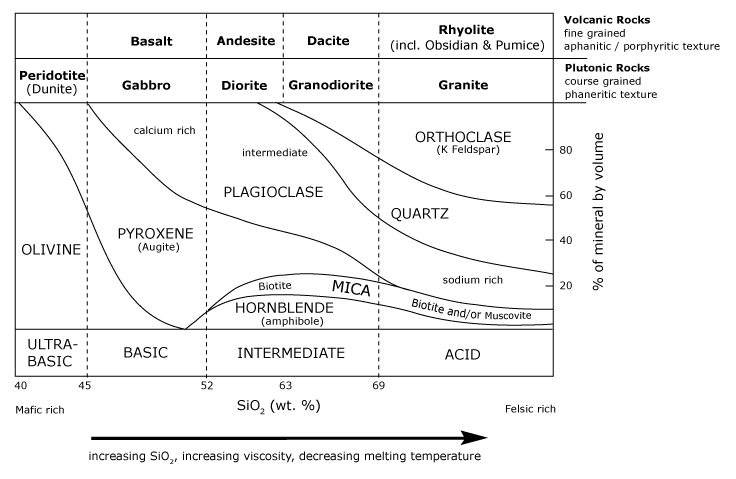
| Andesite is an extrusive rock intermediate in composition between rhyolite and basalt. Andesite lava is of moderate viscosity and forms thick lava flows and domes. The word andesite is derived from the Andes Mountains in South America, where andesite is common. Andesite is the volcanic equivalent of diorite. | |
|
|
|
| Group: | Volcanic (Extrusive) |
|---|---|
| Color: | variable, but typically bluish-grey or grey (lighter coloured than basalt). |
| Texture: | porphyritic |
| Mineral content | groundmass generally of pyroxene (augite) and plagioclase, possibly with minor amounts of amphibole (hornblende) and glass; phenocrysts of plagioclase and often pyroxene, occasionally olivine or amphibole. |
| Silica (SiO2) content: | 52%-63%. |
| Uses: | can be used as aggregate, fill etc. in the construction and roading industries (often not ideal for concrete aggregate because of high silica content). |
| Basalt is a mafic extrusive rock, is the most widespread of all igneous rocks, and comprises more than 90% of all volcanic rocks. Because of its relatively low silica content, basalt lava has a comparatively low viscosity, and forms thin flows that can travel long distances. It is also found as intrusive dikes and sills. Many moon rocks brought back by Apollo astronauts are of basaltic composition. Basalt is the volcanic equivalent of gabbro. | |
|
|
|
| Group: | Volcanic (Extrusive) |
|---|---|
| Color: | dark grey to black. |
| Texture: | aphanitic (can be porphyritic). |
| Mineral content | groundmass generally of pyroxene (augite), plagioclase and olivine, possibly with minor glass; if porphyritic the phenocrysts will be any of olivine, pyroxene or plagioclase. |
| Silica (SiO2) content: | 45%-52%. |
| Uses: | aggregate, fill etc. in the construction and roading industries (best if olivine content is low); armour rock for seawalls; dimension stone, e.g. stone walls, curb stones, paving stones etc. |
| Dacite is a felsic extrusive rock, intermediate in composition between andesite and rhyolite. It is often found associated with andesite, and forms lava flows, dikes, and, in some cases, massive intrusions in the centres of old volcanoes. Dacite is the volcanic equivalent of granodiorite. | |
|
|
|
| Group: | Volcanic (Extrusive) |
|---|---|
| Color: | variable, but generally bluish-grey or pale grey. |
| Texture: | generally porphyritic. |
| Mineral content | groundmass generally of plagioclase with amphibole (hornblende), biotite, pyroxene (augite), quartz, and glass; phenocrysts of plagioclase, amphibole and often quartz. |
| Silica (SiO2) content: | 63%-69%. |
| Uses: | can be used as aggregate, fill etc. in the construction and roading industries (often not ideal for concrete aggregate because of high silica content). |
| Diorite is an intrusive rock intermediate in composition between gabbro and granite. It is produced in volcanic arcs, and in mountain building where it can occur in large volumes as batholiths in the roots of mountains (e.g. Scotland, Norway). Because it is commonly speckled black and white, it is often referred to as "salt and pepper" rock. Diorite is the plutonic equivalent of andesite. | |
|
|
|
| Group: | Plutonic (Intrusive) |
|---|---|
| Color: | typically speckled black and white. |
| Texture: | phaneritic (medium to coarse grained). |
| Mineral content | plagioclase, amphibole (hornblende) and / or pyroxene (augite). |
| Silica (SiO2) content: | 52%-63%. |
| Uses: | can be used as aggregate, fill etc. in the construction and roading industries (often not ideal for concrete aggregate because of high silica content); cut and polished for dimension stone for building facings, foyers etc. |
| Gabbro is a dense, mafic intrusive rock. It generally occurs as batholiths and laccoliths and is often found along mid-ocean ridges or in ancient mountains composed of compressed and uplifted oceanic crust. Gabbro is the plutonic equivalent of basalt. | |
|
|
|
| Group: | Plutonic (Intrusive) |
|---|---|
| Color: | dark grey to black. |
| Texture: | phaneritic (medium to coarse grained). |
| Mineral content | predominantly plagioclase and pyroxene (augite) with lesser olivine. |
| Silica (SiO2) content: | 45%-52%. |
| Uses: | as aggregate, fill etc. in the construction and roading industries; cut and polished for dimension stone (called black granite) for building facings, foyers etc. |
| Granite is a felsic, generally equigranular, relatively light coloured intrusive rock. It comprises some of the oldest known rocks on Earth, and is the most abundant basement rock underlying the relatively thin sedimentary rock cover of the continents. Granite is produced in volcanic arcs, and more commonly in mountain building resulting from the collision of two continental masses. The earliest continental masses were products of the accumulation of volcanic arcs, and this is why granite lies in the cores of all of the continents. Granite is the plutonic equivalent of rhyolite. | |
|
|
|
| Group: | Plutonic (Intrusive) |
|---|---|
| Color: | variable but typically light-coloured. |
| Texture: | phaneritic (medium to coarse grained). |
| Mineral content | orthoclase, plagioclase and quartz (generally more orthoclase than plagioclase), often with smaller amounts of biotite, muscovite or amphibole (hornblende). |
| Silica (SiO2) content: | 69%-77%. |
| Uses: | can be used as aggregate, fill etc. in the construction and roading industries (often not ideal for concrete aggregate because of high silica content); cut and polished for dimension stone for building facings, foyers etc; cut and polished for bench tops and counters; cut and carved into monuments, headstones, statues etc. |
| Granodiorite is an intrusive rock, intermediate in composition between diorite and granite. Although often similar in appearance to diorite or granite, it has a higher quartz content than diorite, and a higher mafic mineral content than granite. It is commonly produced in volcanic arcs, and in mountain building where it emplaces as large batholiths in mountain roots. Granodiorite is the plutonic equivalent of dacite. | |
|
|
|
| Group: | Plutonic (Intrusive) |
|---|---|
| Color: | variable but typically light-coloured. |
| Texture: | phaneritic (medium to coarse grained). |
| Mineral content | quartz, plagioclase, with lesser orthoclase, biotite (these separate it from diorite) and amphibole ( hornblende) (plagioclase always greater than 2/3 of total feldspar). |
| Silica (SiO2) content: | 63%-69%. |
| Uses: | can be used as aggregate, fill etc. in the construction and roading industries (often not ideal for concrete aggregate because of high silica content); cut and polished for dimension stone for building facings, foyers etc. |
| Ignimbrite is a pumice-dominated pyroclastic flow deposit formed from the cooling of pyroclastic material ejected from an explosive volcanic eruption. As the pyroclastic material settles it can build up thick layers, and if the temperature is sufficiently high (> 535°C) it can weld into rock. The degree of welding depends on the weight of overlying material, so at the tops of such deposits the rock is commonly vesicular and of low density, while at depth the overlying weight crushes the pyroclastic material forming a dense, non-vesicular rock. While most volcanic rocks are found close to the eruptive source, ignimbrite of reasonable thickness can often be found tens to hundreds of kilometres from the site of eruption. | |
|
|
|
| Group: | Volcanic (Extrusive) |
|---|---|
| Color: | variable, typically light-coloured (e.g. pinkish-white, pale grey etc). |
| Texture: | aphanitic if not welded, eutaxitic if welded. |
| Mineral content | pumice clasts in a fine grained glassy matrix, may contain lithic clasts and / or phenocrysts of varying composition. |
| Silica (SiO2) content: | NA. |
| Uses: | building stone for decorative walls, paving etc. |
| Peridotite is a very dense, coarse-grained, olivine-rich, ultra- mafic intrusive rock. It is noted for its low silica content, and contains very little or no feldspar ( orthoclase, plagioclase). It is a common component of oceanic lithosphere, and is derived from the upper mantle. It is found on land as part of oceanic crust sequences called ophiolites which have been thrust in or on to a continental mass, or as localised intrusions. | |
|
|
|
| Group: | Plutonic (Intrusive) |
|---|---|
| Color: | generally dark greenish-grey. |
| Texture: | phaneritic (coarse grained). |
| Mineral content | generally olivine with lesser pyroxene ( augite) (dunite is dominantly olivine), always contains some metallic minerals, e.g. chromite, magnetite. |
| Silica (SiO2) content: | < 45%. |
| Uses: | as a source of valuable ores and minerals, including chromite, platinum, nickel and precious garnet; diamonds are obtained from mica-rich peridotite (kimberlite) in South Africa. |
| Rhyolite is a felsic extrusive rock. Due to the high silica content, rhyolite lava is very viscous. It flows slowly, like tooth paste squeezed out of a tube, and tends to pile up and form lava domes. If rhyolite magma is gas rich it can erupt explosively, forming a frothy solidified magma called pumice (a very lightweight, light-coloured, vesicular form of rhyolite) along with ash deposits, and / or ignimbrite. In certain situations extremely porous rhyolite lava flows may develop. The extreme porosity of such flows allows degassing and subsequent collapse of the flow, forming obsidian (dark coloured volcanic glass). Rhyolite is the volcanic equivalent of granite. | |
|
|
|
| Group: | Volcanic (Extrusive) |
|---|---|
| Color: | variable, but light coloured. |
| Texture: | usually porphyritic, but can be aphanitic (e.g. obsidian). |
| Mineral content | groundmass generally of quartz and plagioclase, with lesser amounts of orthoclase, biotite, amphibole (augite), pyroxene (hornblende), and glass; phenocrysts of plagioclase and quartz, often with amphibole and / or biotite, sometimes orthoclase. |
| Silica (SiO2) content: | 69%-77%. |
| Uses: | can be used as aggregate, fill etc. in the construction and roading industries (often not ideal for concrete aggregate because of high silica content); obsidian was used by pre-European Maori as a cutting tool, and can be carved into jewellery; pumice is used as an abrasive (especially in the cosmetic industry), and can also be incorporated into lightweight building materials. |
| Syenite is an intrusive rock, belonging to the alkali series of intermediate plutonic rocks. Alkali feldspar (e.g. orthoclase) is the major mineral component of syenite, total feldspar content is > 65%, and quartz is typically lacking. It is found in continental settings, and typically results from partial melting of the lower crust. Syenite is the plutonic equivalent of trachyte. | |
|
|
|
| Group: | Plutonic (Intrusive) |
|---|---|
| Color: | variable but typically light coloured. |
| Texture: | phaneritic (medium to coarse grained). |
| Mineral content | orthoclase, with lesser to minor plagioclase, minor mica, augite, hornblende, magnetite etc. |
| Silica (SiO2) content: | 60%-65%. |
| Uses: | dimension stone for building facings, foyers etc (often preferred to granite due to its better fire-resistant qualities); can be used as aggregate in the building and roading industries. |
| Trachyte is an extrusive rock, belonging to the alkali series of intermediate volcanic rocks. The major mineral component of trachyte is alkali feldspar (e.g. orthoclase), and it generally contains no quartz. Trachyte often displays trachytic texture, where acicular to tabular feldspar phenocrysts align in one direction, suggestive of flow prior to cooling. Trachyte lava is of moderate viscosity and forms thick lava flows and domes. Two famous trachyte volcanoes are Mt Kilimanjaro (the highest mountain on the African continent), and Mt Erebus in Antarctica. Trachyte is the volcanic equivalent of syenite. | |
|
|
|
| Group: | Volcanic (Extrusive) |
|---|---|
| Color: | variable but often light coloured, generally light coloured phenocrysts. |
| Texture: | generally porphyritic (can be trachytic), sometimes aphanitic. |
| Mineral content | orthoclase phenocrysts in a groundmass of orthoclase with minor plagioclase, biotite, hornblende, augite etc.. |
| Silica (SiO2) content: | 60%-65%. |
| Uses: | building and paving stone; dimension stone for building facings, foyers etc. |

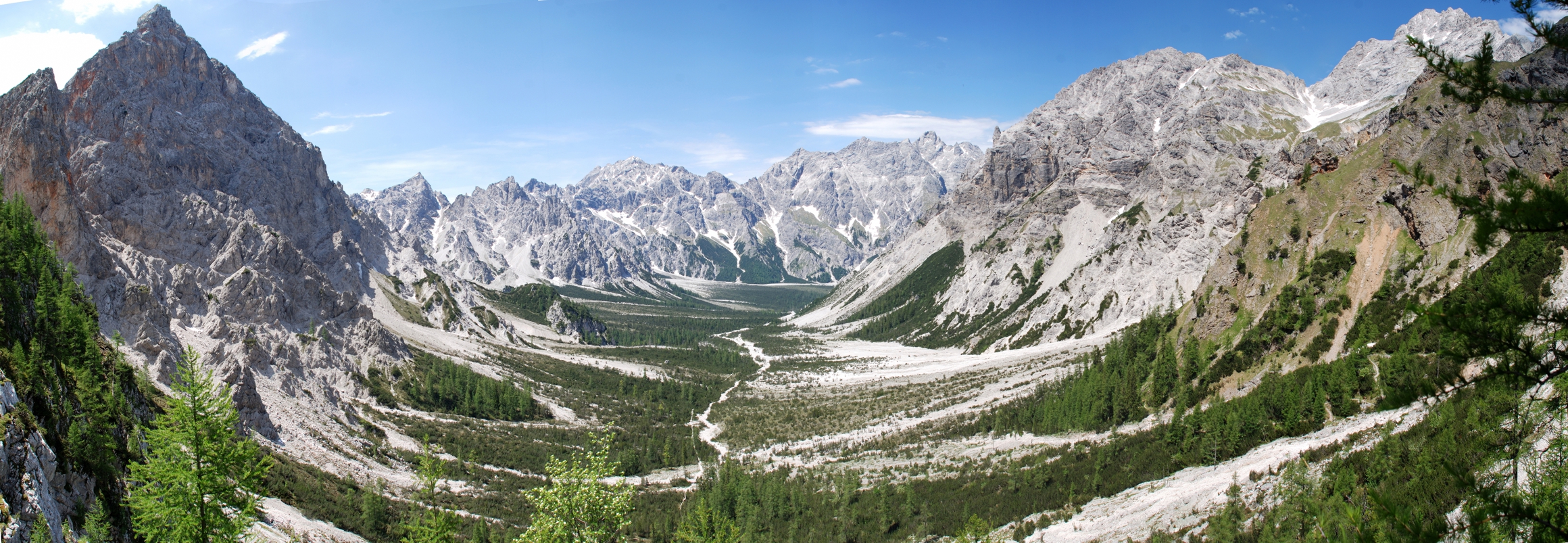
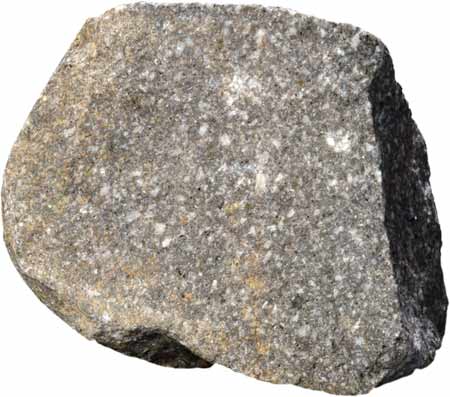 andesite
andesite
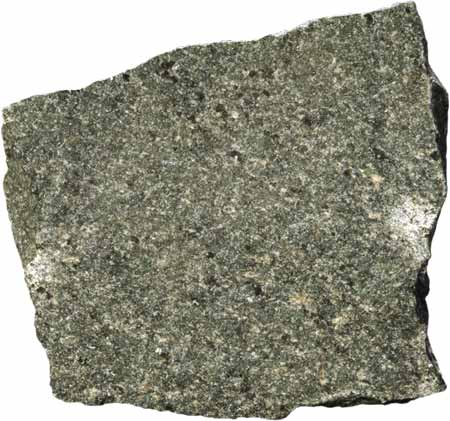 andesite
andesite
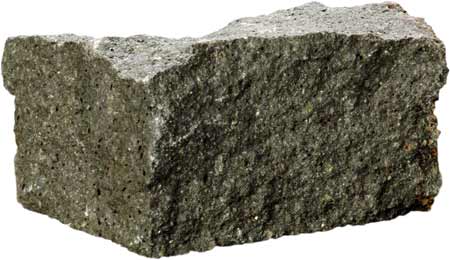 basalt
basalt
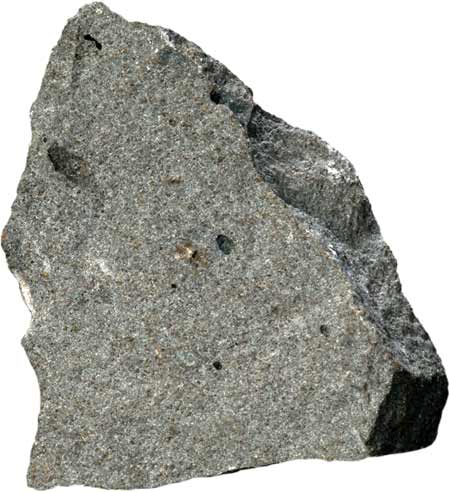 basalt
basalt
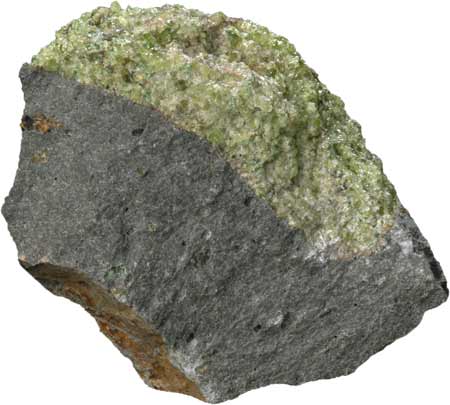 basalt with olivine
basalt with olivine
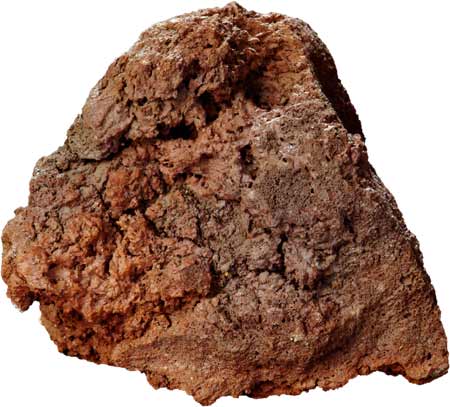 basalt (scoriaceous)
basalt (scoriaceous)
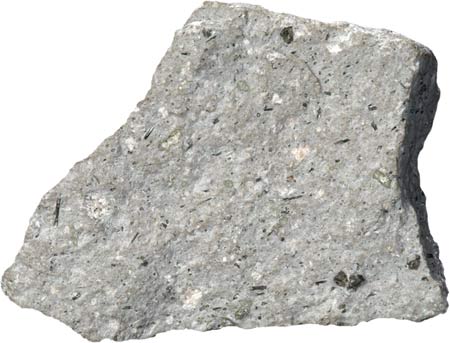 dacite
dacite
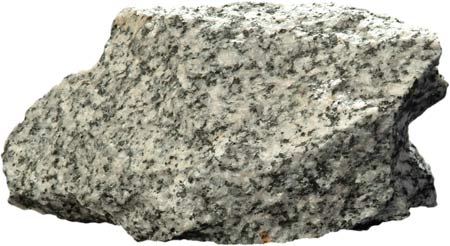 diorite
diorite
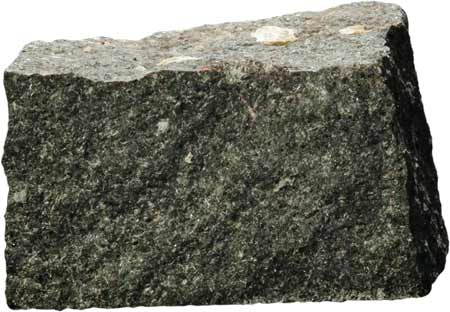 gabbro
gabbro
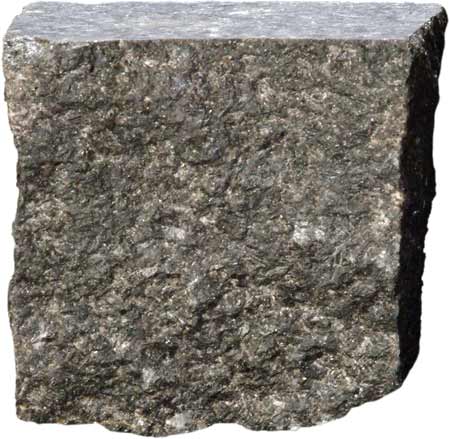 gabbro
gabbro
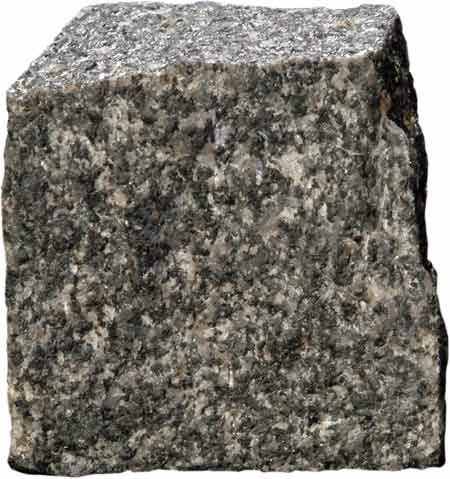 gabbro
gabbro
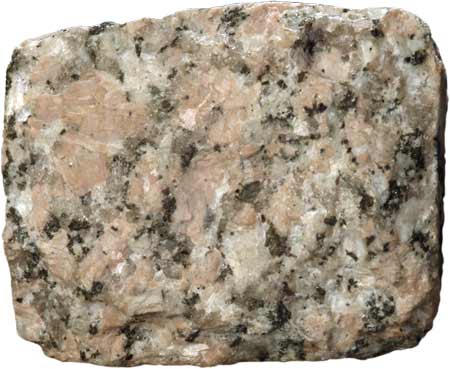 granite
granite
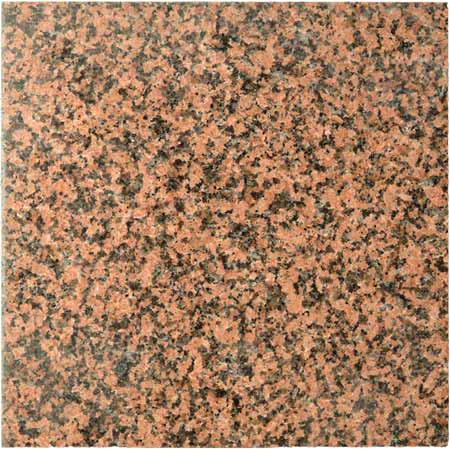 granite (cut)
granite (cut)
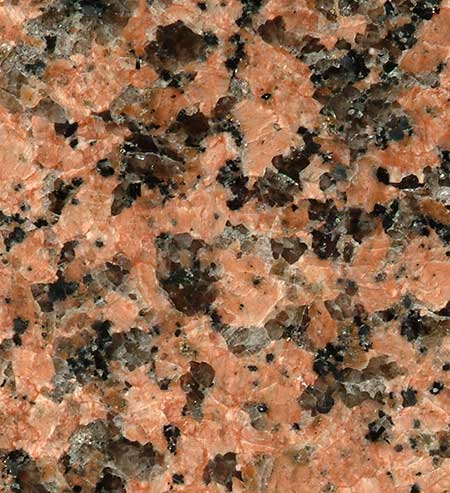 granite (magnified)
granite (magnified)
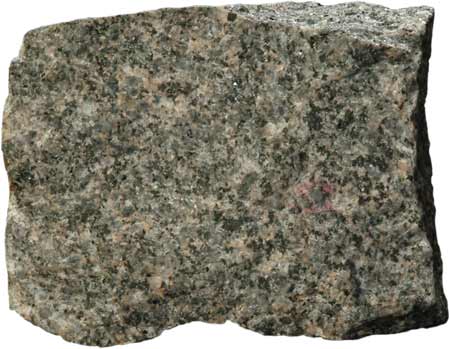 granodiorite
granodiorite
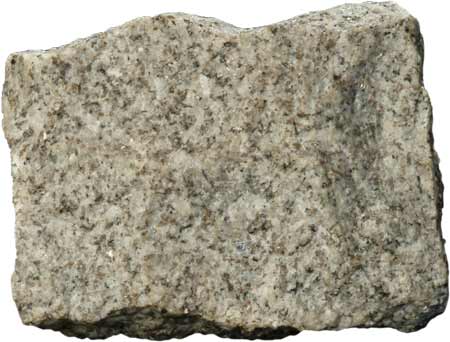 granodiorite
granodiorite
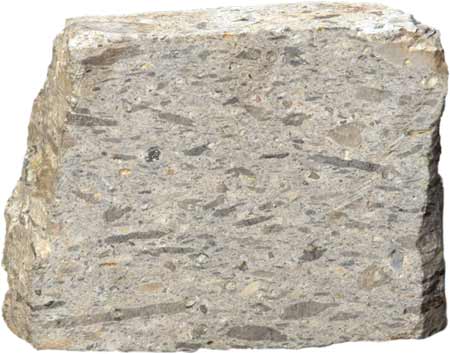 ignimbrite (welded)
ignimbrite (welded)
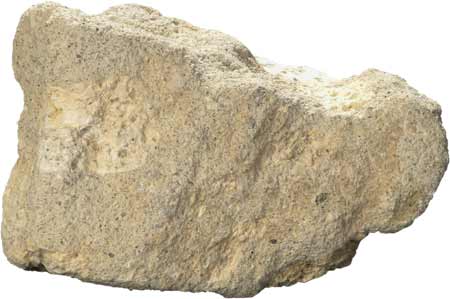 ignimbrite (poorly welded)
ignimbrite (poorly welded)
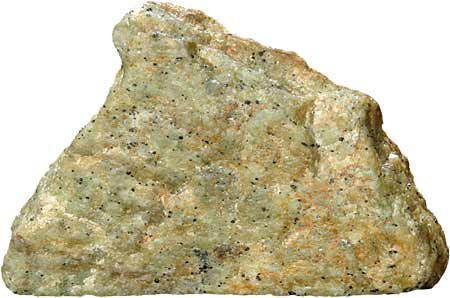 peridotite
peridotite
 rhyolite
rhyolite
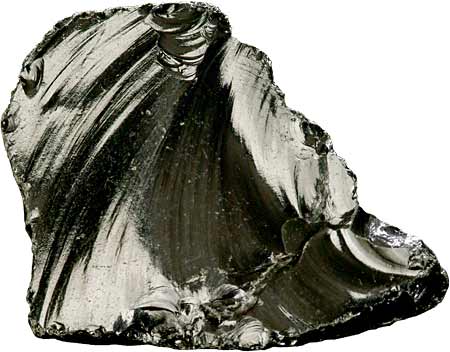 rhyolite (obsidian)
rhyolite (obsidian)
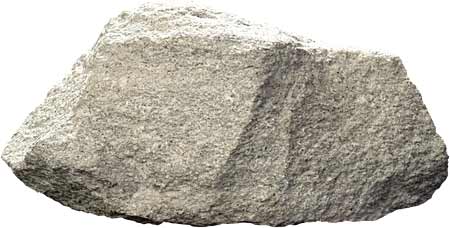 rhyolite
rhyolite
 rhyolite (pumice)
rhyolite (pumice)
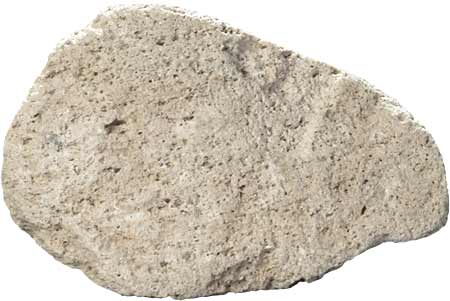 rhyolite (pumice)
rhyolite (pumice)
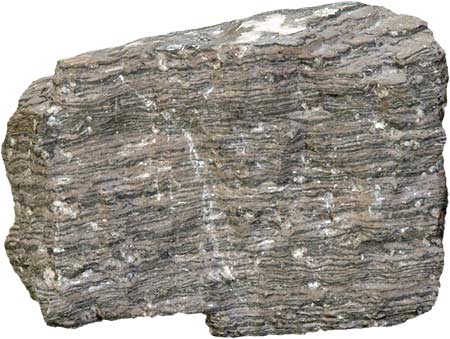 rhyolite (flow banded)
rhyolite (flow banded)
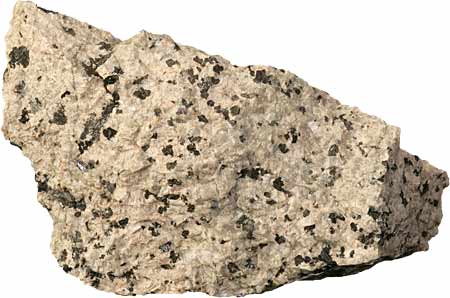 syenite
syenite
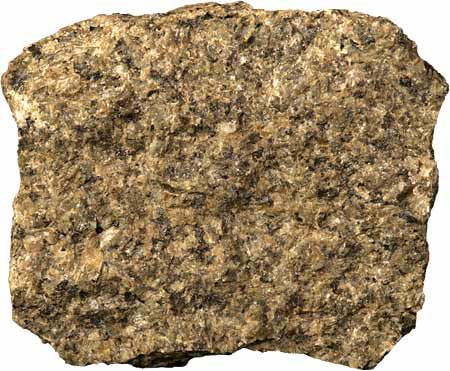 syenite
syenite
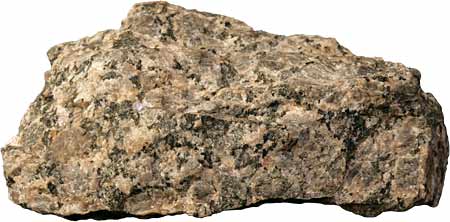 syenite
syenite
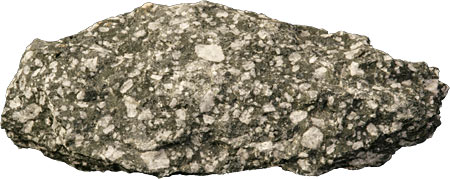 trachyte
trachyte
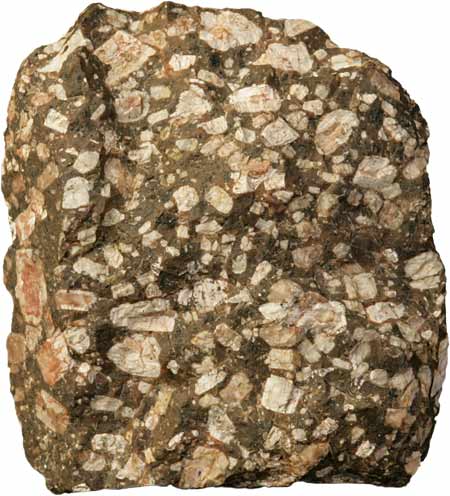 trachyte
trachyte